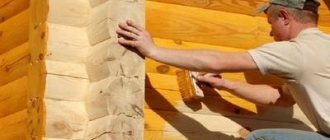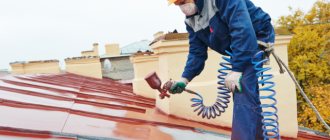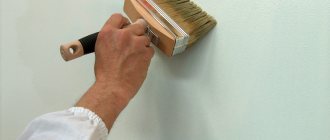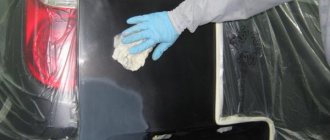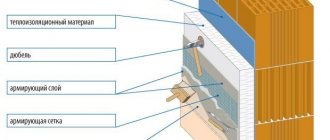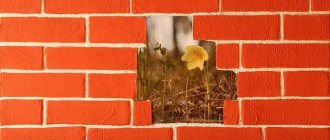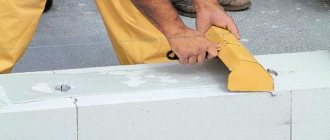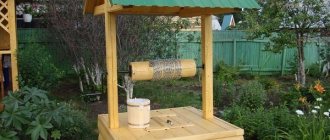Properties and characteristics of polyvinyl acetate paint
The composition of PVA paint includes:
- The main component is polyvinyl acetate in an aqueous environment.
- Coloring particles.
- Stabilizers, whose main purpose is to improve the technical performance of the suspension.
- Plasticizers characterized by the ability to regulate physical and mechanical parameters. Responsible for the film-forming function.
The principle of operation of polyvinyl acetate emulsion paints, as well as all types of water-based emulsions, is the evaporation of water included in the composition.
This serves as the starting point for the process of hardening of the connecting structural components and, as a result, the formation of a durable waterproof layer on the surface. The decorative base has a porous matte texture.
Such suspensions have a fairly wide range of applications, ranging from painting interior spaces to finishing work in industrial and commercial buildings.
PVA paints interact well and adhere well to concrete, gypsum, plastered, wooden substrates, including plywood and wood-fiber, as well as previously painted surfaces, in particular, oil-based compositions.
It is not recommended to apply polyvinyl acetate paint on surfaces previously treated with alum, alumina or vitriol primer liquid.
Specifications
- density – 1.25–1.55 kg/dm3;
- hiding power (according to DIN EN 13300) – class 1–2 class;
- resistance to wet abrasion (DIN EN 13300) – class 2–class 3;
- water absorption coefficient ≤ 0.1 kg/(m²∙h 0.5);
- degree of grinding – ≤ 30–70 µm;
- pH – 6.8–8.2;
- consumption per 1 layer – 150–200 ml/m2;
- application temperature – +5/+30 ° C;
- Complete drying time – 4 hours.
Water-based composition with silicone filler
Water-based composition containing silicone resin. The peculiarity of this dye: it applies to mineral surfaces without preliminary treatment with primers, masks cracks up to 2 mm wide. The dried layer has a high vapor permeability rate; it is recommended to use the paint in a damp, damp room, on surfaces that accumulate condensation or atmospheric moisture. Protects the treated area from fungal and mold damage.
Dye disadvantage:
- High cost compared to other water-based emulsions.
Advantages and disadvantages of PVA paint
The quality and characteristics of polyvinyl acetate paint largely depend on the concentration and type of the main polymer binder. But if we look at it in general, then all paints of the type under consideration are endowed with a large number of undeniable advantages.
The main one is the hydrophobicity of the resulting layer. However, not all types of PVA compositions are water resistant.
At the same time, the decorative base is vapor permeable, which will prevent the appearance of mold and provide a comfortable microclimate by absorbing excess moisture vapor.
Interior polyvinyl acetate paint is quite elastic, this allows it to cover microcracks not exceeding 1 mm in size. The surface is durable and wear-resistant with minimal likelihood of cracking.
The undoubted advantage of polyvinyl acetate compounds is their environmental friendliness. When applied they have a non-toxic neutral odor. They are fire resistant.
Another feature of such emulsions is light fastness, the minimum value of which, depending on the variety, is 5, due to the uniform distribution of coloring pigments in the structure.
Therefore, a surface painted with PVA paint will delight you with its rich colors for a long time. Facade emulsions perfectly withstand the effects of precipitation.
Polyvinyl acetate paint for interior work is 100% resistant to alkali and various detergents, which indicates its practicality. Once hardened, it is completely insensitive to mineral oils and fats.
It is also worth noting the durability of the applied layer, which allows you not to repaint the base for at least 5 years.
The main disadvantages of polyvinyl acetate emulsion paints:
The possibility of not only applying, but also storing the prepared suspension at a temperature not lower than +5°C. If the temperature regime is not observed, paint tends to lose its original characteristics.
The need for careful preparation of the base, especially wood, due to the high surface tension. Therefore, wooden surfaces must first be cleaned and sanded in several stages.
Correct application
Correct adherence to a certain order in performing work is the key to success. This must also be observed when painting:
- first you need to make a choice of a certain type of coating (it all depends on the conditions of application and operation);
- then preparatory work will be required: removing dust and whitewash, leveling and eliminating cracks;
- primer;
- preparation of paintwork materials;
- applying paint and varnish to the surface;
- When applying the second layer, it is necessary to wait until the first layer has completely dried to identify unpainted areas and other defects.
Thus, polyvinyl acetate water-based paint does not belong to universal finishing materials. However, the range of her work is quite wide. The price of these compounds is pleasing to the eye, given the high quality and constant compliance with GOST. Thanks to this paint, anyone can do repairs, not just a professional painter.
From the following video you will learn the secrets of ideally preparing walls for painting.
Paint selection
The universal composition of polyvinyl acetate paint, characterized by elasticity, practicality and durability, has found new life as a result of the use of acrylic as a binding agent. Thanks to the acrylic base, the already excellent performance characteristics of the paint are significantly enhanced.
When choosing between local and imported manufacturers, the only difference can be in price, that is, foreign batches will cost an order of magnitude more.
It should also be remembered that European companies try to optimize products for their climatic conditions, so the characteristics declared by them may not be suitable for a particular region, especially with rather harsh or, conversely, tropical climatic conditions. Therefore, this is a plus for local manufacturers.
For facade work, it is recommended to give preference to moisture- and light-resistant compounds with an antistatic effect. For interiors, you can buy paint with an average value, unless, of course, we are talking about a bathroom or kitchen.
It is necessary to know the exact consumption of the emulsion in order to purchase the required displacement. Consumption directly depends on the degree of coverage of the suspension, which, according to the modern standard DIN EN 13300, is expressed in classes.
Their numerical number indicates the number of layers required for high-quality coating of the base. Density is also considered a determining factor for consumption - the denser the PVA emulsion, the correspondingly larger amount is needed to cover the surface.
Operating procedure
As an instruction on how to work with polyvinyl acetate paints (PVA), we will provide this video in which craftsmen paint walls with similar paint:
Now a short summary for printing. Firstly, we check and select the coloring composition for suitability for use in a given room or location. Secondly, we prepare the working area for painting: we remove dust and dirt, seal cracks and seams, wash the whitewashed surface; to save money, you can apply a primer first. Thirdly, we remove dried lumps, stir the polyvinyl acetate paint, dilute the water-based composition with water according to the instructions, depending on the application method (brush, roller or spray). The final step is to apply several layers.
Painting the base
Having selected a suitable composition that satisfies the operating conditions, it’s time to move on to preparing the base. The plane is leveled, treated with construction mesh (sanded) and primed. For polyvinyl acetate emulsion, it is best to cover the base with several layers of primer.
The function of the primer is not only to ensure adhesion, but also to level out the absorbent properties of the surface, which in the future will lead to more economical consumption of the suspension.
To prepare the paint, mix it with water in the amount indicated on the package. The emulsion is applied in 1–2 layers using traditional tools or a spray gun.
Eco-friendly and practical, polyvinyl acetate emulsion paint is an ideal option for decorating interior surfaces. The painted surface will differ not only in its unique technical characteristics, but also in its aesthetics.
Peculiarities
Such paints and varnishes are extremely popular due to:
- wide choice of colors;
- High Quality;
- affordable price;
- the ability to choose between a matte surface and gloss;
- all companies follow a certain GOST-28196 89, which allows us to draw conclusions about quality.
PVA is a specific composition, which includes:
- emulsion;
- paint pigments;
- stabilizers;
- plasticizers.
Polyvinyl acetate water-based paint is sold in two versions:
- In one package. This is a finished product, you can work with it right away. The main condition for storage is the tightness of the packaging, as well as the absence of sub-zero temperatures.
- In two packs. It is sold as a semi-finished product and consists of two components that are in different packages. One contains the paint itself in the form of a paste, and the second package contains a plasticizer. Before starting work, both components must be mixed in one container, and after that you can start working.
Dyeing technology
Painting surfaces using PVA is carried out according to the following algorithm:
- Traces of dirt, dust and old paint are removed from the surface.
- Defects on the working surface are repaired.
- A primer is applied to the surface, and then the selected dye is applied with a roller or brush in 2-3 layers.
In order for the dye to acquire improved properties, it is recommended to treat each layer with sandpaper after drying. This increases adhesion. Therefore, each subsequent layer penetrates better into the structure of the surface being treated.
See also
Types of primers for drywall and how to make it yourself, their use
Scope of application
As a rule, painting with polyvinyl acetate water-based compositions is carried out during interior finishing work. Facades are not covered with this product due to the complex “relationship” with water (unless we are talking about the acrylic version). Accordingly, it is also not suitable for rooms with high humidity. Ideal for:
- tree;
- concrete;
- brick;
- drywall;
- plaster;
- glass.
PVA paint can be applied over an oil layer. But it does not work on vitriol, alum, alumina primers. Metal surfaces are also taboo in most cases. The only way out is to pre-coat them with oil paint.
Thus, polyvinyl acetate water-based emulsion is, although not a universal option, but in many cases it is optimal. Its affordable price against the backdrop of high quality looks especially attractive. And the ease of use makes the paint especially popular among those who carry out repair work in their home or office on their own, without resorting to the services of construction companies and crews.
